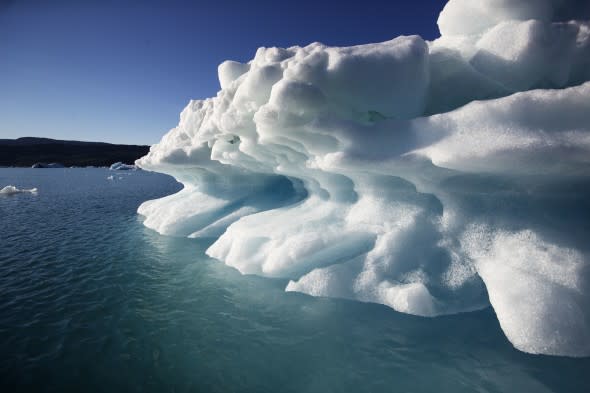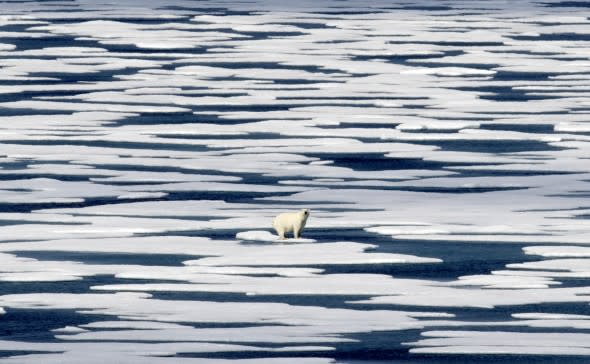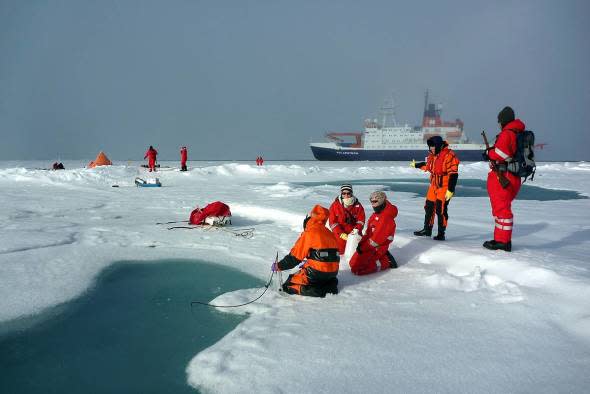New and emerging threats continue to appear in Arctic as region warms, 2018 Arctic Report Card says
In the year 2018, surface air temperatures in the Arctic continued to warm at roughly twice the rate relative to the rest of the globe. It was the second warmest year, second only to 2016, on record in the Arctic since 1900, at +1.7 C relative to the long-term average between 1981 and 2010.
This year continues to follow a trend of Arctic warming and sea ice melting. All five years since 2014 have been warmer than any prior records, according to an annual report by the National Oceanic and Atmospheric Administration (NOAA).
The NOAA's 2018 Arctic Report Card was released on Tuesday, Dec. 11, at the American Geophysical Union fall meeting. This is the report's 13th year, and it reflects on a range of land, ice and ocean observations made throughout the Arctic during the 2018 calendar year.
"The environmental changes in the Arctic underscore why NOAA continues to invest in Arctic research and activities, which improve the nation's economic competitiveness, national security, and the sustainable management of natural resources," retired Navy Rear Adm. Timothy Gallaudet, Ph.D., acting under secretary of commerce for oceans and atmosphere at NOAA, said in the press release.

An icebergs floats in the Nuup Kangerlua Fjord near Nuuk in southwestern Greenland, Tuesday Aug. 1, 2017. Greenland's glaciers have been melting and retreating at an accelerated pace in recent years due to warmer temperatures. (AP Photo/David Goldman)
The report includes a series of 14 essays written by more than 80 scientists from 12 countries. As in previous years, this update highlights the changes that continue to occur in the Arctic environmental system.
This information can be used to inform decisions by local, state and federal leaders as Arctic residents confront the challenges and opportunities posed by a rapidly changing climate and ecosystem.
"This report will also help guide NOAA's priorities in better understanding the role of the Arctic in climate change and extreme weather; sustaining and growing fisheries; and supporting adaptation and economic opportunities in the region," Gallaudet said.
This year's report shows that the Arctic region experienced the second-highest air temperatures ever recorded, the second-lowest overall sea-ice coverage, lowest recorded winter ice in the Bering Sea and earlier plankton blooms due to early melting of sea ice in the Bering Sea.
The report included annual updates on ocean temperature, snow cover, tundra greenness and melting on the Greenland Ice Sheet.
It also includes reports on multi-year environmental changes, including a long-term population decline of the region's iconic wildlife species, the caribou, as well as other essays focused on the expansion northward of toxic harmful algae and significant concentrations of microplastic pollution that are transported by ocean currents into the Arctic Ocean.
"When I look at the report, one of the big takeaways from this year is that it really shows how interconnected things are," Dr. Donald Perovich, professor at the Thayer School of Engineering at Dartmouth College, said at the press conference. "We're really starting to see cascading effects that we don't fully understand."

A polar bear stands on the ice in the Franklin Strait in the Canadian Arctic Archipelago on July 22, 2017. While some polar bears are expected to follow the retreating ice northward, others will head south, where they will come into greater contact with humans, encounters that are unlikely to end well for the bears. (AP Photo/David Goldman, file)
Growing atmospheric warmth in the Arctic results in a sluggish and unusually wavy jet stream, which coincided with abnormal weather events in both the Arctic and mid-latitudes. Some examples are the heat wave at the North Pole in autumn 2017, a swarm of severe winter storms in the eastern United States in 2018 and the extreme cold outbreak in Europe in March 2018.
In the terrestrial system, atmospheric warming continued to drive broad, long-term trends in declining terrestrial snowcover, melting of the Greenland Ice Sheet and lake ice, increasing summertime Arctic river discharge and the expansion and greening of Arctic tundra vegetation, the report says.
Despite the growth of vegetation available for grazing land animals, herd populations of caribou and wild reindeer across the Arctic tundra have declined by nearly 50 percent over the last two decades.
The Arctic Ocean has lost 95 percent of its oldest, thickest ice. In 2018, Arctic sea ice remained younger and thinner and covered less area than in the past. The 12 lowest extents in the satellite record have occurred in the last 12 years, according to the report.
Pan-Arctic observations suggest a long-term decline in coastal landfast sea ice, sea ice that is fastened to the coastline, since measurements began in the 1970s. Landfast sea ice is an important platform for hunting, traveling and coastal protection for local communities.
Warming Arctic Ocean conditions are also coinciding with an expansion of harmful algae species responsible for toxic algal blooms in the Arctic Ocean. Considerable concentrations of algal toxins have been found in the tissues of Arctic clams, seals, walrus, whales and other marine organisms.
Continued expansion of harmful algal blooms is expected to have significant impacts in a region where traditional monitoring programs for toxins in shellfish, fish or other food sources are not feasible due to remote and expansive coastlines.

(Mar Fernandez)
Marine microplastics is another emerging threat taking form in the Arctic. A recent global survey of marine microplastics revealed that concentrations in the remote Arctic Ocean are higher than all other ocean basins in the world.
The handful of existing monitoring programs in the Arctic shows microplastics contamination has increased over the last decade and poses a threat to seabirds and marine life that can become entangled or ingest debris.
The collective results reported in the 2018 Arctic Report Card show the effects of persistent Arctic warming continue to mount.
New and rapidly emerging threats are taking form and highlighting the level of uncertainty in the scope of environmental change that is to come.
"Changes are occurring, and what we need to do is adapt to those changes. We can adapt as a country effectively by better understanding improving our observations and our predictions," Gallaudet said.
Long-term monitoring programs are critical to our understanding of baseline conditions, as well as the magnitude and frequency of the changes in the Arctic, according to the report.
Such understanding is central to the livelihood of Arctic communities as well as the rest of the globe, which is already experiencing the changes and implications of a warming and melting Arctic.
